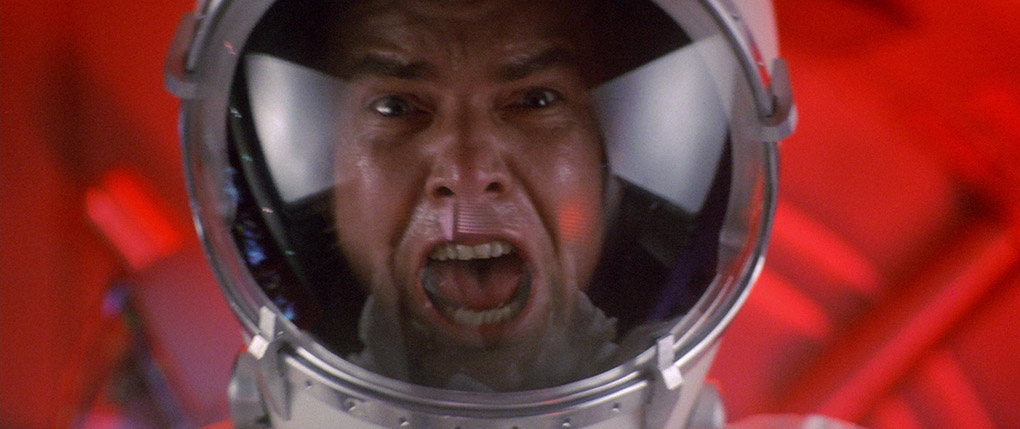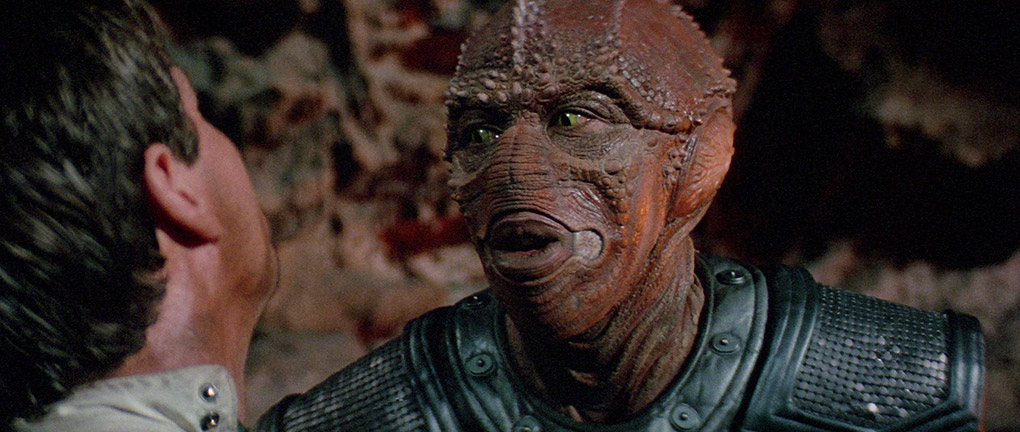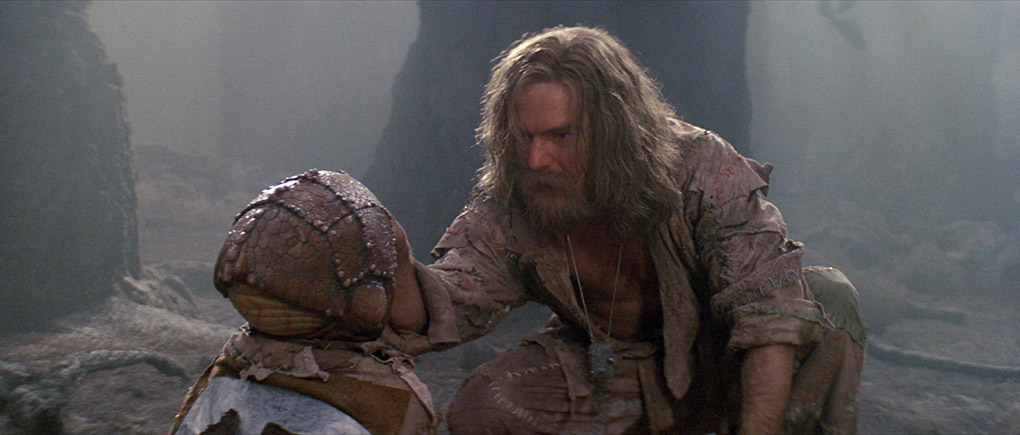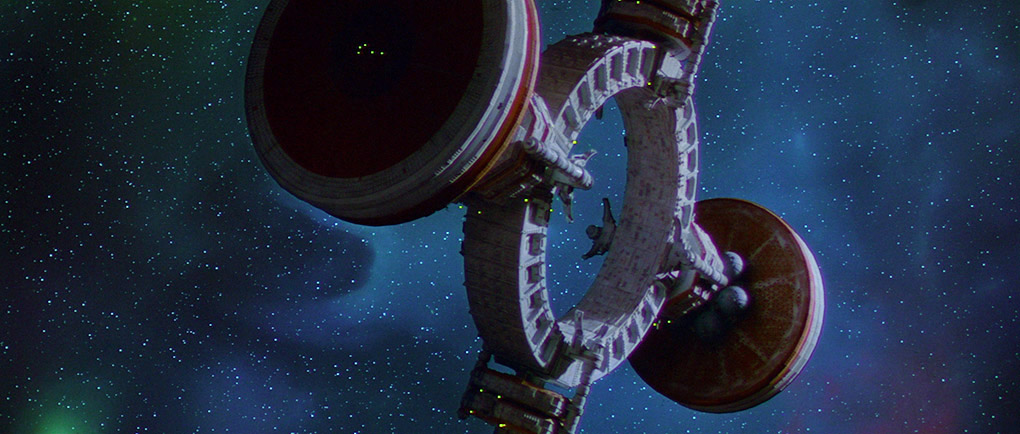|
You can never go home again, or so we are told. How many times have you revisited a movie you enjoyed in your youth and been left wondering what that younger incarnation of you was thinking? In my case, not that many. Those 50s science fiction films that gave me nightmares as a kid still look great today, and revisiting The Texas Chain Saw Massacre on Blu-Ray a couple of years back nearly had me cacking my pants in fear all over again. But once the 70s drew to a close, all bets were off. The 80s have just about the worst rep of any decade in living memory. The fashions and hairstyles have dated as painfully as those of the 60s, but instead of great drugs and free love we suffered an infestation of squash-playing, Filofax-waving capitalist dickwads singing Hallelujahs in the church of unfettered greed. A free DVD to anyone who kicked one of these guys sharply in the balls. I'm expecting proof.
We film devotees also remember it as a time in which loud exploitation cinema thrived, when the popularity of the slasher movie rose and fell, and when the smart, director-led films of the 1970s gave way to crass studio money-chasers with pop music tie-in deals. Only with the passing of time and a growing nostalgia for anything that was popular in the pre-digital age have we begun to appreciate that some of those 80s Hollywood movies were actually pretty good. That said, I'm talking from the prejudiced viewpoint of someone who all but stopped going to see mainstream American movies somewhere in the middle of that cursed decade and instead embraced the dirtier but somehow more honest pleasures of cheapjack exploitation cinema. There are a whole string of now highly regarded 80s American mainstream movies and a fair few cult favourites that I really dislike and which I'll not invite a flame war from readers by naming here. Some I failed to connect with from the very first viewing, while others I seem to remember rather enjoying but groaning and shifting uncomfortably in my seat when revisiting them at a later date.

All of which brings me to Enemy Mine, the second English language film from German director Wolfgang Petersen, whose 1981 Das Boot is my absolute favourite submarine movie. As it happens I recall rather enjoying this when I trotted along to see it on its cinema release. It wasn't a big hit. Despite being made in the wake of the Star Wars sequels (and I'm sorry, but I'm never going to refer to the original Star Wars by its ridiculous retitle, 'A New Hope'), when science fiction adventure tales were expected by default to be licences to print money, Enemy Mine made back less than a third of its estimated $40 million budget on its Thanksgiving holiday season release. Yet like so many not so often talked-about genre films of the period, it's now rather fondly remembered and has even been championed as a forgotten science fiction classic. Really? I recall it being fun, but not that much fun. Either way, it seemed an odd film for a distributor like Eureka to pick up for Blu-ray distribution, but more power to that splendid company's steadily widening catalogue. And I was rather looking forward to revisiting it, though I should point out that the job of reviewing the disc fell to me only after Camus and Slarek had passed on it. What made me a little nervous was that they both did so after re-watching the film. Should I have read anything into that?
Enemy Mine is built around a familiar set-up in interesting clothing. In the frantic midst of a galactic territorial war between humankind and a reptilian alien race known as the Dracs, a furious dogfight sees space jock and Drac-hater Willis E. Davidge (Dennis Quaid) and the ship he was chasing crash land on the life-supporting planet of Fyrine IV. Both Davidge and his Drac adversary Jeriba Shigan (Louis Gossett Jr.) make it out of their respective crafts relatively unscathed, and after some initial hostilities between them, the two realise that they will have to work together if they are to survive.

If you think you've somehow heard this one before then there's a good chance you have. In 1968, John Boorman directed Hell in the Pacific, which cast Lee Marvin and Toshirô Mifune as solitary American and Japanese soldiers who become marooned on an uninhabited Pacific island during WW2 and have to learn to accept each other's differences and cooperate to stay alive. And in 1970, an episode of Gerry Anderson's alien invasion series UFO entitled Survival saw human astronaut Paul Foster having to work with the occupant of a downed alien craft on the Moon's surface to similar ends. This does at first glance make Enemy Mine sound like a feature film expansion of that TV show episode, but there are a couple of crucial differences here. In Survival, this evolving and grippingly handled fight for life is only part of the story, whereas in Enemy Mine it's the dominant element of the film's first half and the catalyst for plot development in the second. But while this story strand unfolds in gripping silence in Survival, as a mainstream movie with its eye on an audience whose attention span was perceived to only stretch so far, Enemy Mine seems unwilling to let even the most obvious plot points pass without verbal commentary. Thus the tantalising opportunity to have the two protagonists develop a non-verbal form of communication is discarded early on by casting Davidge as an arrogant motormouth who verbalises his thoughts and barks protests at Shigan like one of those western tourists who believes that anyone, whatever their nationality or background, can understand English if you say something loudly and repeatedly at them. This determination to spoon-feed the plot points to the slower audience members also sees Shigan learn English at a seemingly logic-defying speed so that the two can converse and steer clear of thoughtful silence. That said, I'm willing to cut the film some slack here, as it's perfectly possible that Dracs have ultra-keen linguistic skills, although considering that Shigan is soon more eloquent in his use of the English language than the man he is presumably learning it from, I began to suspect that there was a book titled English for Dracs tucked away amongst the objects he managed to salvage from his ship. Rather more annoying is the perceived need to underscore some of the most obvious aspects of plot and character development by treating us to Davidge's thoughts in voice-over, which Quaid delivers in unexcited monotone. Apocalypse Now this ain't.
Enemy Mine is very much a product of 80s American cinema, from its tonal brashness and breezy pacing to Tony Imi's colourful cinematography and Maurice Jarre's occasionally strident score. Characters are painted with broad brush strokes – we're left in no doubt by the opening minutes that Davidge is a bigot with a hatred for Dracs – all of which peaks a little embarassingly with a pair of slave traders (one of whom is played by Blade Runner's Brion James) who actually cackle like evil pantomime villains as they approach their helpless prey. The film also includes a sequence that found its way into a few too many mainstream dramas and comedies of the period, one born of 'new man' gender politics that I can't discuss without giving away the story's most inventive twist.

For an alien world, Fyrine IV often feels as studio-bound a setting as Star Trek: The Next Generation's famous 'Planet Hell', which series fans will recall was the setting for the third season episode, The Enemy, which was a partial remake of this very film, as was the Star Trek: Enterprise season 2 episode, Dawn. The slight air of artificiality this lends the proceedings is carried over into Shigan's facial makeup, as while largely impressive in its design and execution, it's hard to ignore the fact (especially in HD) that there's a visible gap between Louis Gossett Jr.'s very flexible mouth and the more solid reptilian features that surround it. This, in turn, made it hard for me to shake off the impression that I was watching a human wearing a carefully crafted alien mask.
Enemy Mine (and what a smart title that is) met with mixed reviews on its original release but has since found favour in cult genre circles. I guess it's all a matter of taste. As I inferred above, some of the crimes of 80s mainstream cinema have in retrospect been reduced to misdemeanours, and films we once dismissed for their loudness and lack of cinematic subtlety are now being celebrated for their don't-give-a-crap energy. Blame nostalgia if you will, but a quick breeze through Arrow Video's back catalogue reveals some once-dismissed titles that are now regarded as gems of exploitation and even studio cinema. Whether Enemy Mine falls into this camp will very much be a matter of opinion. For me it hasn't aged as well as I'd hoped. Maybe I'm just pining for what might have been, for a tension-filled first half built around the conflict between the two castaways and their inability to communicate, for more rounded characters with genuine depth, for dialogue that sparks and for stabs at wit that actually put a smile on my face, and for a story told in more cinematic terms, without resorting to the crutch of verbalising everything.
But there are some intriguing ideas at work here and the odd scene that still delivers exactly as intended. And while it probably won't win any prizes for subtlety, the film's overriding message about working to understand and find common ground with the people you have been conditioned to believe are a threat to everything you supposedly hold dear is as sadly pertinent today as it was back in 1985.
Like 'em or not, we expect our studio funded science fiction movies to look boffo on Blu-ray, and the transfer here doesn't disappoint. Framed in its original 2.35:1 aspect ratio, the image is in consistently spanking shape, with the crisp picture detail, well balanced contrast and lively colours really shining in the opening space combat scenes (which really look terrific, even if a couple of the effects to show) but still holding their own on the planet when the light levels drop and the environmental colour palette narrows. There's not a dust spot or trace of damage anywhere, and the image sits rock solidly in frame. Great job.

The DTS-HD master audio 5.0 is a lively affair, with excellent clarity, a very decent dynamic range, and some very distinct frontal separation. There is a slight treble bias – note that the track is 5.0 rather than 5.1, so no LFE bass work here. The Linear PCM 2.0 stereo track is also very clear but not as vivid in its frontal separation and the treble bias is more pronounced here.
There's also an isolated music and effects track for those who enjoy that sort of thing, which is Linear PCM stereo.
Optional English subtitles for the deaf and hearing impaired are also included.
Trailer (1:59)
Disconcertingly scored with extracts from Philip Glass's score for Mishima, this is a predictable but perfectly serviceable sell that includes the bloody spoiler I was careful to dance around.
Extended Scene (3:07)
A longer, cropped-to-4:3 version of a later scene that I can't really describe without skirting with spoilers (I'm sure the trailer makers would be happy to tell you all about it) and which intrigues for being dubbed in German and subtitled back into English. The dubbing's rather good, as it happens.
Booklet
The centrepiece of this typically well produced booklet is a detailed history of the film's inception, production and release by Craig Ian Mann, who thoughtfully includes a spoiler warning before discussing the film proper. Credits and notes on viewing are also included.
I know for a fact that some are all excited for this release and for them the quality of the transfer alone should justify the asking price, even if they feel a tad short-changed by the extras. Science fiction devotees and fans of 80s cinema should certainly check it out and there's a good chance many of them will also enjoy it. It certainly has its charms, and on the right day and in the right mood I'm sure I'd warm to it more than I did. But that's my problem. Others will disagree and so they're right to do so, and they should have no complaints about how it looks and sounds here.
|